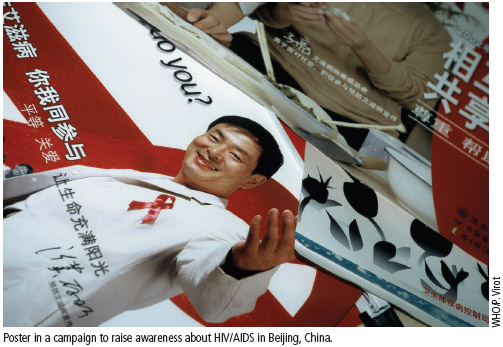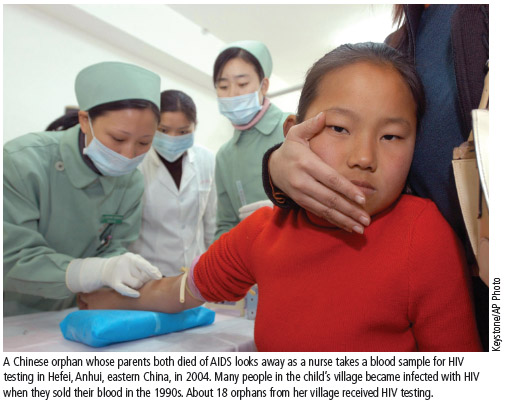NEWS
China's pragmatic approach to AIDS
Jane Parry
Hong Kong SAR
International public health experts are praising China for a new openness that will be key to effective control of HIV/AIDS. Despite a recent downward revision of its HIV/AIDS estimates, China faces a growing epidemic. Its ambitious public health plans include free HIV testing and AIDS treatment and a nationwide rollout of methadone therapy to help drug users lower their risk of contracting HIV.
As recently as the late 1990s, Chinese experts projected that the country's HIV infections would top 10 million by 2010. Now the government is aiming to keep that number below 1.5 million. In 2003, an estimated 840 000 people in China were infected with HIV, but in 2005 the estimate was revised down to 650 000. Taking these numbers on face value, it may seem that China is winning the war on HIV/AIDS, but the reality is not so rosy.
The HIV/AIDS epidemic continues to spread particularly among vulnerable populations in China: last year alone there were an estimated 70 000 new infections. Implementing the country's ambitious HIV/AIDS prevention, treatment and care programme is no easy task. China, a vast country of 1.3 billion people, faces tremendous logistical challenges. Even with strong policy measures in place, one challenge is to ensure that central government policy is implemented at provincial and local levels.
In late January 2006 China's Ministry of Health, UNAIDS and WHO released the 2005 Update on the HIV/AIDS Epidemic and Response in China, a report that presents China's new, lower HIV/AIDS estimates as well as progress made in responding to the epidemic, the challenges that remain, and the government's vision for the future.
Joel Rehnstrom, UNAIDS Country Coordinator in China, recalls some concern in the Chinese Government about releasing lower estimates for fear of appearing to massage the figures estimates that are attributable to more accurate surveillance in 2005.
"The government wanted to make sure that UNAIDS and WHO were behind it. We have endorsed the new estimate, but cannot certify the provincial and prefectural estimates which are the basis for the national one," he says.
"This report represents several years of work by UNAIDS and WHO and others in strengthening surveillance in China, training people in epidemiology and surveillance, getting people to understand more the dynamics of HIV transmission in a low prevalence situation. This is not something that was come up with overnight; it's not a back of the envelope estimate. What the report very clearly says is that China has a growing epidemic," Rehnstrom adds.
Injection drug users (IDUs) and sex workers comprise the majority of the estimated 650 000 people in China who are infected with HIV. An estimated 288 000 44% of the total are IDUs, while 127 000 (19.6%) are sex workers and their clients, and 109 000 (16.7%) are the partners of HIV-positive people or other members of the population.
The remaining 126 000 include men who have sex with men, children born to HIV-positive mothers, and donors infected through unsafe commercial blood and plasma collection practices in the 1990s. An estimated 55 000 people (8.5%), down from the 2003 estimate of 199 000, have been infected in this way. This group constitute a distinctive aspect of the country's HIV/AIDS epidemic. The sharp downward revision is because many donors have died and unsafe blood collection practices have long ceased.

The HIV/AIDS epidemic started to emerge in China in the early 1990s, but it was not until Premier Wen Jiabao became the first senior leader to visit villages affected by blood and plasma trading and shake hands with AIDS patients on World AIDS Day in 2003 that central government sent a signal to provincial and county-level leaders to address HIV/AIDS. The 2005 report with revised estimates is a further example of China's determination to control the disease.
"Although the Chinese Government was a bit slow to respond in the beginning, it is now starting to make up for lost time," says Katharine Poundstone, HIV/AIDS Technical Officer with the WHO Country Office in China, adding: "While the time it has lost in the past means it has serious problems to face, the current response is quite forward-looking and promising, and backed by the highest levels of government".
"Five years ago I would have said that China is 10 years behind other countries and not taking full advantage of lessons learned in other parts of the world; now I would say China is becoming one of the leaders in the global HIV response. Over the coming years, the world will probably learn a lot from the various programmes that China is now launching to combat its HIV epidemic. Some are very ambitious, such as the nationwide roll-out of methadone maintenance therapy to help drug users manage opiate addiction and lower their risk of HIV, and some are rather controversial, such as China's mass HIV screening programmes," Poundstone says.
The screening programmes that started in 2004 raise ethical concerns as to whether they adhere to three main principles of effective voluntary counselling and testing (VCT): confidentiality, counselling and consent, and practical concerns that regular mass screening is not cost-effective in a vast country with low HIV prevalence.
Screening programmes have focused on former blood donors, IDUs and sex workers. Drug use and sex work are illegal in China, so many IDUs and sex workers live in detention centres where it is easy to provide screening and education. At community level, however, the illegality of drug use and sex work makes education and prevention difficult, explains Graham Smith, Country Director for the International HIV/AIDS Alliance China, headquartered in Kunming, Yunnan Province.
"If HIV/AIDS really has a low prevalence then there's still plenty of scope to step in and turn the situation around, but it's about prevention coverage in IDUs and sex workers, and the problem there is the public security angle. The government response is a public order response and that response contradicts public health objectives. It makes it very difficult to get access to the population but there are incremental steps that can make it easier," he says.

Small-scale projects are part of that incremental approach. For example, the charity AIDS Concern, based in Hong Kong Special Administrative Region, recently secured funding to set up a drop-in and information centre in Shenzhen, across the border from Hong Kong SAR, covering two districts frequented by sex workers and their clients.
The centre will distribute condoms and provide free, rapid and anonymous HIV testing to sex workers and their clients. "We are very excited about working together with the Shenzhen Center for Disease Control and Prevention on this project. It's further proof of an official attitude change," says Loretta Wong, Executive Director of AIDS Concern.
While Chinese society remains conservative, attitudes to sexuality are changing and AIDS has forced the health authorities to be pragmatic when dealing with high-risk groups such as sex workers and men who have sex with men, says Smith.
Even as China gears up its response to HIV/AIDS, obstacles remain, not least the implementation of free HIV testing and AIDS treatment programmes within a crumbling health service where hospitals are profit-making entities and rural health-care provision has been reduced in the era of economic reform. Official reluctance to fully embrace nongovernmental organizations in the fight against HIV/AIDS also continues to frustrate organizations from within high-risk groups.
"It's still a low-prevalence, concentrated epidemic, both geographically and in terms of population groups, so China has the opportunity to bring the epidemic under control, but there are so many challenges especially at the lower levels," says UNAIDS' Rehnstrom.
By its own admission the central government has an uphill struggle to translate its message into action at local level. "What happens on the ground in a country the size of China is that there is great variability and still a long way to go, says Rehnstrom. "Despite impressive steps forward, the response to HIV/ AIDS is still in its infancy in China." 
